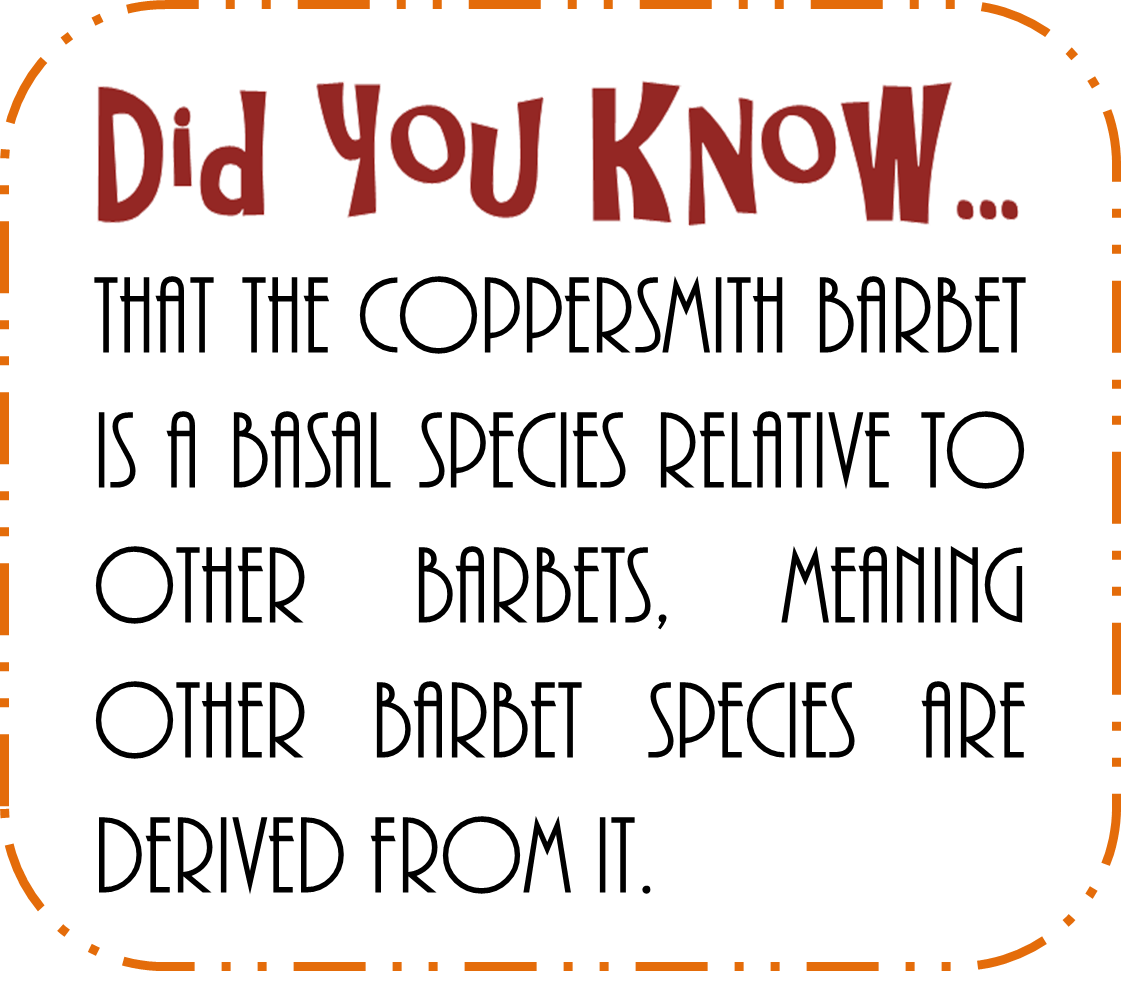| Picture of a Coppersmith barbet bringing fruits to its juveniles by Kunal Sarkar (shuvo), via Wikipedia Commons. |
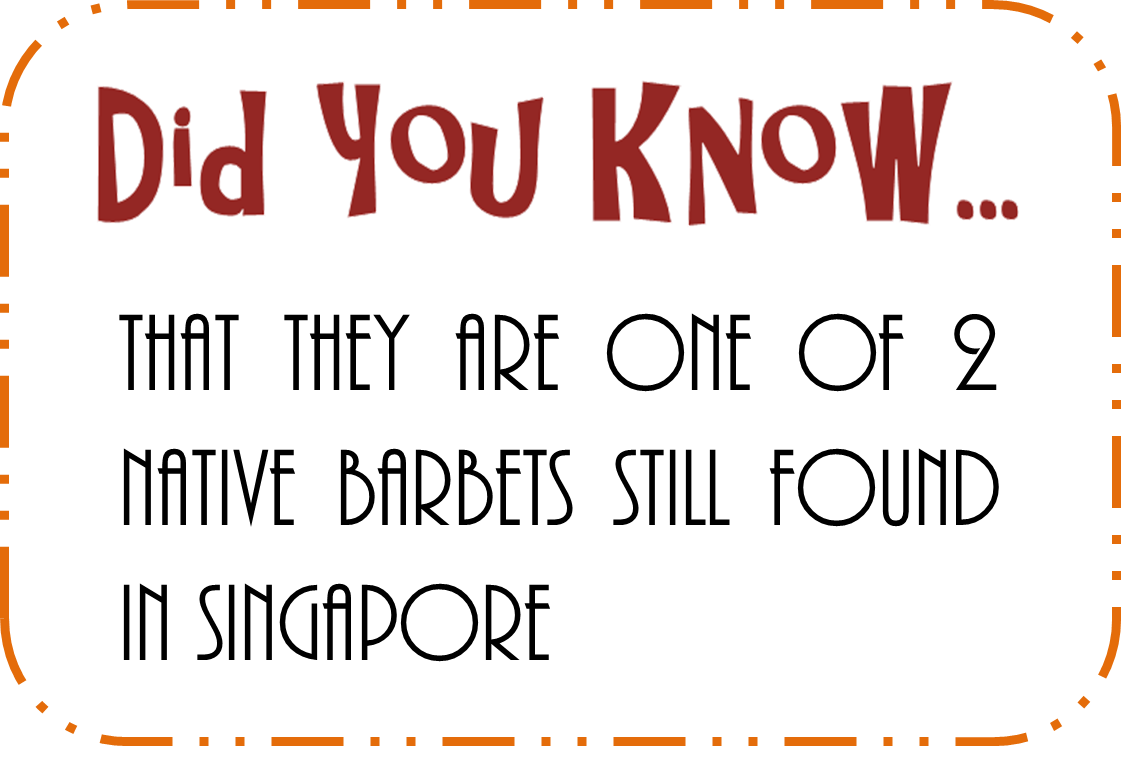 |
| Look for more fun facts about the Coppersmith barbet on this page! |
Table of Contents
1. Introduction
The Coppersmith barbet is one of the three barbet species currently found in Singapore [1] . Originally home to four native barbet species, only two remain while another is a introduced species [2] . This small bird has an unusual call and bright feathering. Barbets are close relatives of the woodpeckers and like woodpeckers, they prefer to nest in holes of a tree. Despite their small size, the Coppersmith barbet is known to dig its nesting holes, like all other barbets [3] .
Singapore is home to one of nine subspecies of the Coppersmith barbet, Psilopogon haemacephalus indica [4] .
2. Nomenclature
The Coppersmith barbet was firstdescribed in 1776 by Statius Muller as Bucco haemacephalus [5] .Binomial (Scientific) name: Psilopogon haemacephalus ( Muller,1776) [6]
Vernacular (Common) names: Coppersmith barbet, Crimson-breasted barbet. (For other names: please refer to http://eol.org/pages/1177697/names/common_names [7] )
Protonym: Bucco haemacephalus [8]
Synonyms: Xantholaema haemacephala, Megalaima haemacephala [9] , Bucco indicus//[10]
3. Etymology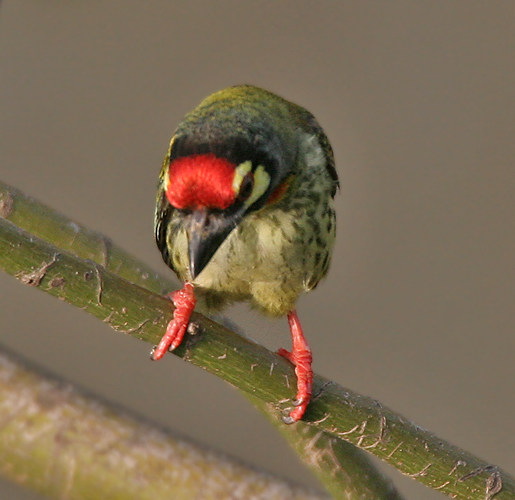
Picture showing the red head of a Coppersmith barbet by J. M. Garg, via Wikimedia Commons.
Barbet, a dimunitive of the French word “barbe” to mean “small beard”. These birds were named for the bristles around their beak that resemble a small beard on the bird [11] .Coppersmith barbet is also named for the characteristic sound that is produced. The sound resembles the tapping of a coppersmith hammer on copper sheets, produced while the beak of the animal is closed [12] . Haemacephalus, where "haem" refers to red[13] with a suffix "cephalus" referring to a condition of the head[14] . Therefore haemacephalus means red-headed.
4. Description
 |
| Photograph by J.M. Garg, via Wikimedia Commons. |
4.1. Morphology
A small brightly colored bird measuring 17cm [15] and weighing 30-53g [16] , the Coppersmith barbet is a small bird with a large head relative to body size. It has a short neck and short tail that is triangular shaped when during flight [17] . It has a large heavy beak relative to the overall size of the bird [18] . This beak is also adorned with small thin noticeable bristles that gave rise to its name [19] . Its eyes are brown with a red eye-ring while its legs are pink[20] .
The Coppersmith barbet is largely green with a green streaked underside [21] . It possesses a brightly colored head, where the nape and crown is green [22] . The red half-collar and forehead complements the yellow eye patch, chin and throat. The colored areas on the head are surrounded by a black coloring that blends into the green of the bird[23] .
There is little sexual dimorphism within this species, with females having a duller red plumage as compared with males [24] . However, juveniles are dull green and lack the bright colors seen in adult individuals [25] .
4.2. Diagnosis
Only three barbet species call Singapore home, the Coppersmith barbet, Lineated barbet and Red-crowned barbet [26] .
Table adapted from Singapore Birds [27]
| Vernacular name |
Coppersmith barbet |
Lineated barbet |
Red-crowned barbet |
| Scientific name |
Psilopogon haemacephalus |
Megalaima lineata |
Megalaima rafflesii |
| Subspecies |
indica |
hodgsoni |
N.A. |
| Image |
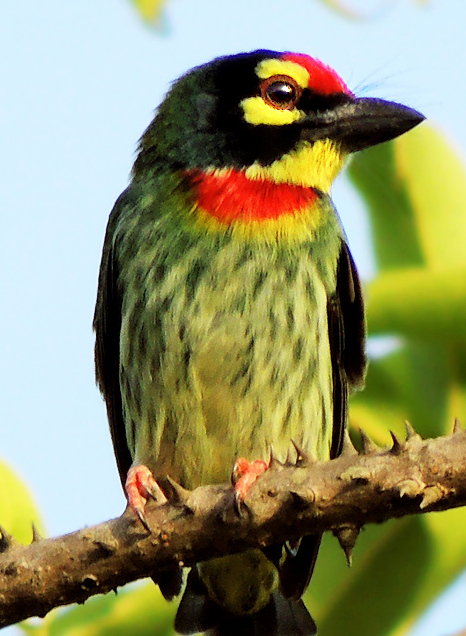 Photograph by Shantanu Kuveskar, via Wikimedia Commons. Photograph by Shantanu Kuveskar, via Wikimedia Commons. |
 Photograph by Lip Kee Yap, via Wikimedia Commons. Photograph by Lip Kee Yap, via Wikimedia Commons. |
 Photograph by Lip Kee Yap, via Wikimedia Commons Photograph by Lip Kee Yap, via Wikimedia Commons |
| Diagnostics |
Short stout bird with a large head relative to body size. Colorful plumage. Red half-collar and forehead. Yellow eye patch, chin and throat. Bright red eye-ring. Black beak adorned with bristles. Juveniles duller. |
Short stout bird with a large head relative to body size. Green body with dark streaks that extend from the head to belly. Yellow eye-ring. Yellow heavy beak adorned with bristles. Juveniles duller. |
Short stout bird with a large head relative to body size. Colorful plumage. Red crown, blue throat with small patch of yellow and red. Black eye-ring. Black heavy beak adorned with bristles. Juveniles duller. |
| Size |
17cm |
27-28cm |
25-27cm |
| Habitat |
Open areas, forest edge |
Wooded areas |
Primary forests |
| Rarity |
Common |
Uncommon (introduced species) |
Uncommon |
5. Behavior and Ecology
5.1. Vocalizations
The Coppersmith barbet has an unusual monotonous call that resembles the drumming of a coppersmith’s hammer on a copper sheet [28] , hence its name (Refer to widget on below for call of Coppersmith barbet[29] ). The ventriloqual properties of this birds call also makes them difficult to spot despite their bright plumage [30] .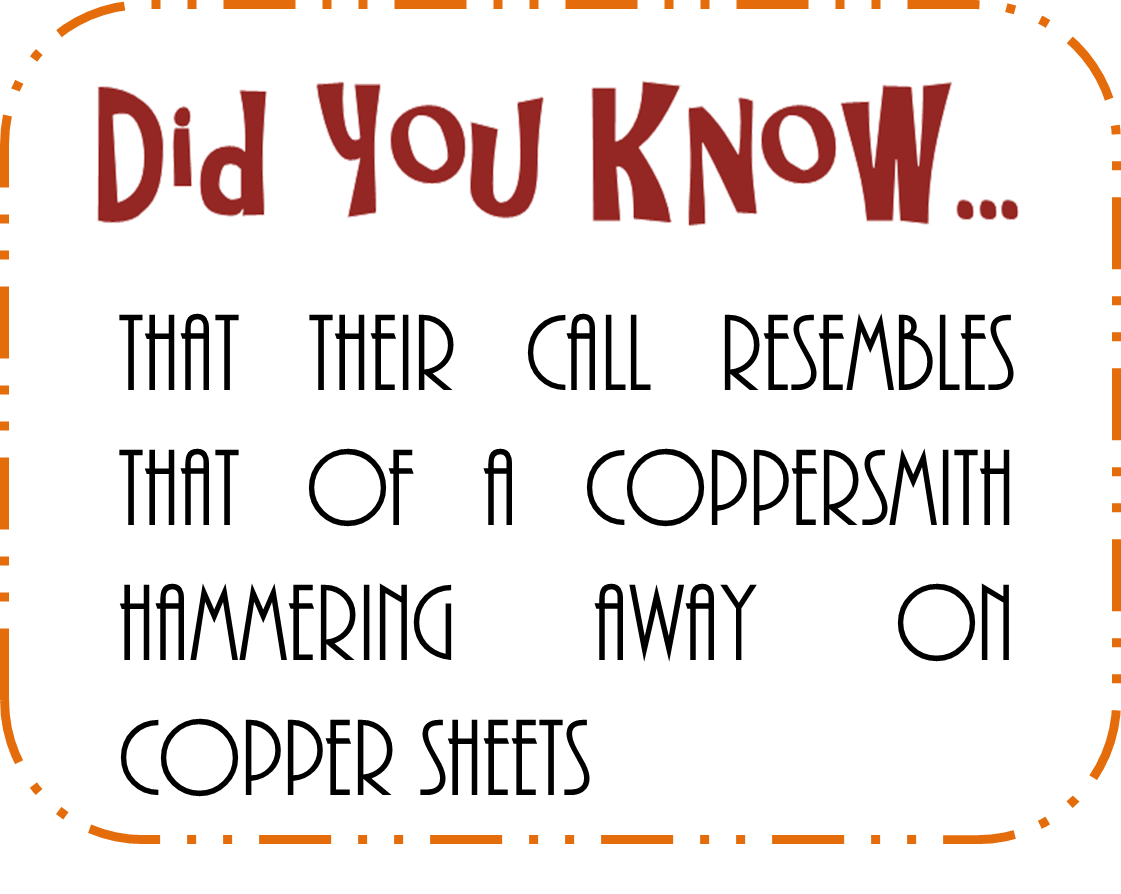 Audio of Coppersmith babet call with sonogram (audio file taken from Xeno-Canto: http://www.xeno-canto.org/200724XC )[31] .
Audio of Coppersmith babet call with sonogram (audio file taken from Xeno-Canto: http://www.xeno-canto.org/200724XC )[31] .The call is repeated and monotonous that can be up to 204 notes long [32] . The Coppersmith barbet builds up its call to an even tempo and volume in warmer months [33] . When calling, the beak of the bird does not open. Instead, two patches of exposed skin on the throat inflate with each note, to produce the signature call of the Coppersmith barbet [34] .
Video featuring Coppersmith barbet call as well as the inflation of the skin on throat during is calls (Video taken by Sheerang Kaulgi retrieved from Youtube: http://www.youtube.com/watch?v=CIKPPdI2ylo) [35] .
5.2. Behavior
Coppersmith barbets are solitary birds, occasionally found in small groups or pairs. They are often seen sunning on top branches in the morning [36] .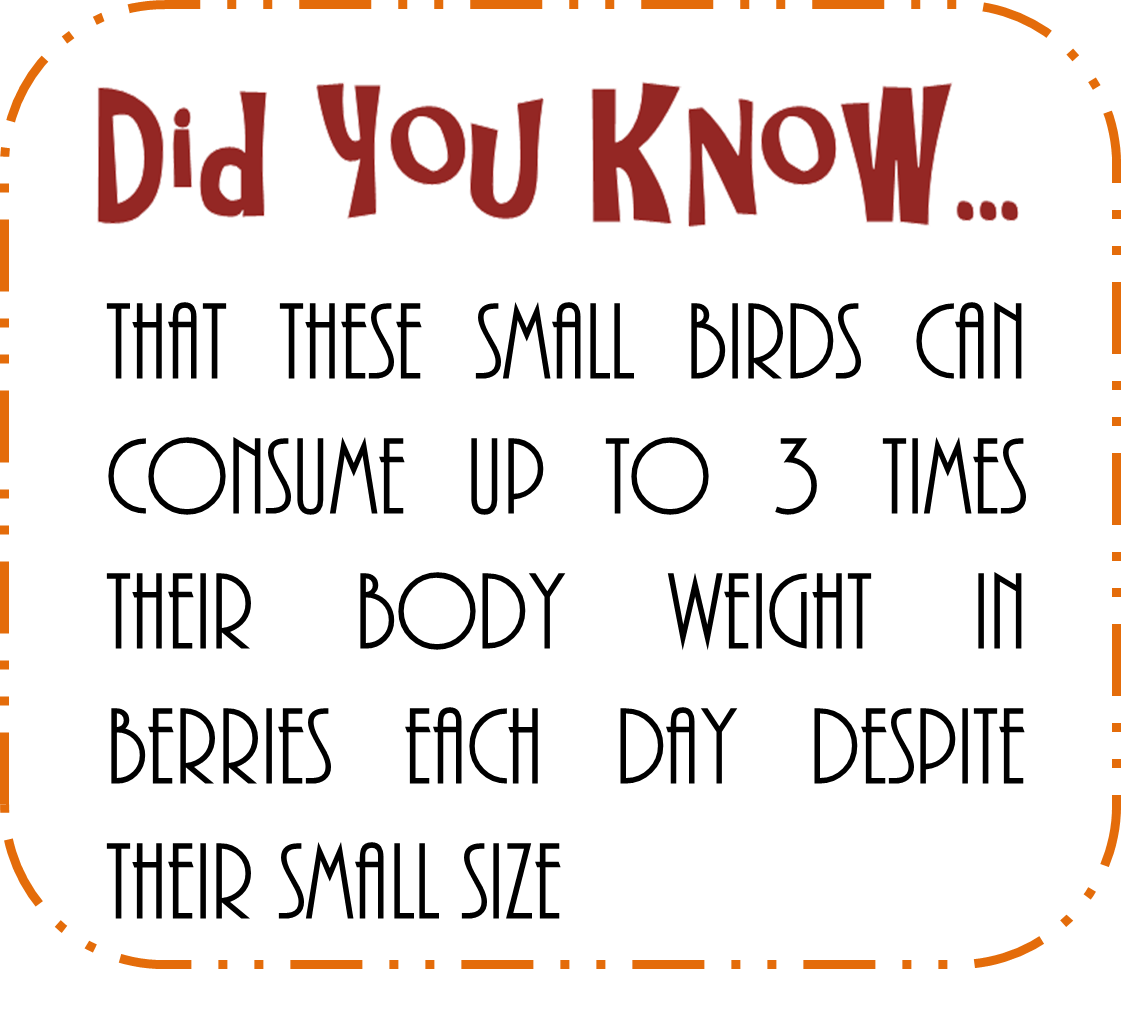
Coppersmith barbets forage in the canopy, on fruiting trees, underparts of leaves and on branch tips. They are also known to strip bark chips to predate on invertebrates [37] .
With a finch-like flight, the coppersmith barbet flight is straight but with swift flaps [38] . They often roost in tree cavities during most of the day [39] .
5.3. Diet
Coppersmith barbets are frugivorous bird, choosing to eat mostly fruits but are also known to feed insects to their young. The coppersmith barbet has a preference for Banyan, Peepul, figs as well as many drupes and berries which are available to them [40] . Some Coppersmith barbets have been observed supplementing their diet with flower petals [41] , presumably to obtain color pigments that they cannot produce. These small birds can consume between 1.5 to three times their weight in fruits each day [42] .On occasion, they are also known to predate on lizards, small frogs, other birds and their eggs [43] .
5.4. Reproduction
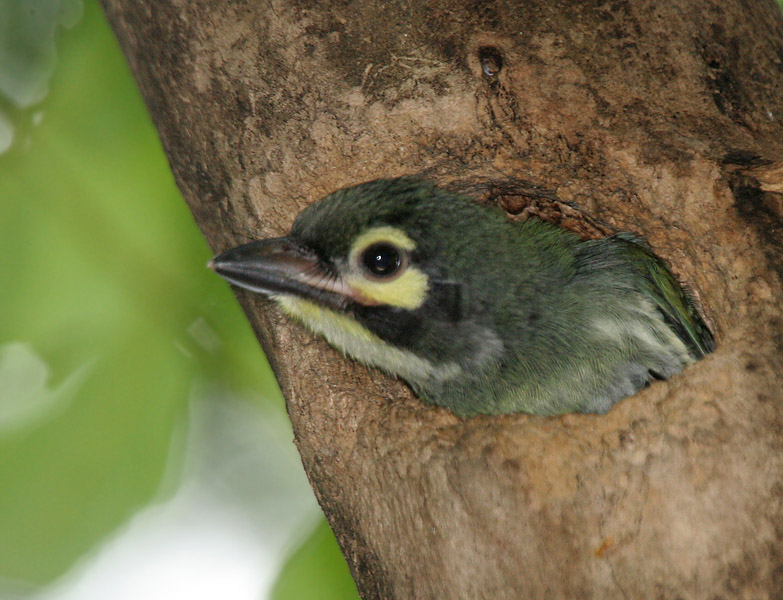 |
| Picture of a Coppersmith barbet in nest by J.M.Garg, via Wikimedia Commons. |
The following table summarizes the reproduction information of Coppersmith barbets [44] .
| Breeding season : |
December to June the following year |
| Preferred nest site : |
Tree cavity |
| Average clutch size : |
3 |
| Hatching rate : |
67% |
| Incubation time : |
14 days |
| Average brood size : |
2 |
| Fledging rate : |
80% |
| Parental care : |
Shared among both male and female at a ratio of 1:1 |
6.Range
6.1. Distribution
6.1.1. WorldwiThe Coppersmith barbet favors open areas and forests edges in the following areas: India and Southeast Asia. There are numerous island populations of subspecies found in Southeast Asia [46] (refer to map below).
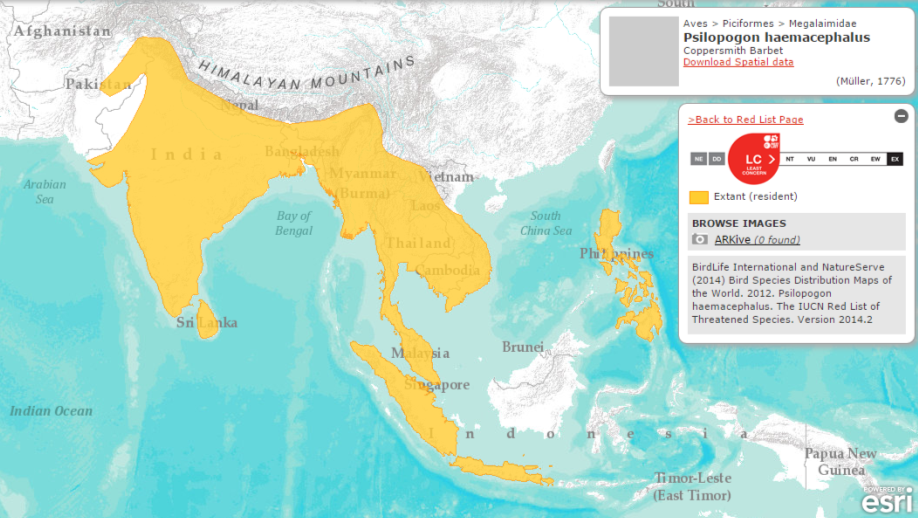 |
| Map showing the distribution of Coppersmith barbets in Asia. Retrieved from IUCN. |
6.1.2.Singapore
In Singapore, Coppersmith barbets can be seen near forest edges and in parks [47] . They have been commonly sighted at Bukit Batok Park [48] as well as at Jurong Lake Park. Their extensive habitat range allows them to live in many of the urban habitats found in Singapore, including at cemeteries [49] .7. Conservation
7.1. IUCN Status
Their extensive distributional range results in their IUCN (International Union for the Conservation of Nature) classification of Least Concern [50] . Any taxons classified under Least Concern by IUCN are widespread and abundant [51] .In addition, the Coppersmith barbet population has an increasing trend [52] and as such is not at the threshold to be classified as Vulnerable.7.2. Threats
The Coppersmith barbet population is not currently facing any threats that can result in the extinction of the taxon. However, habitat destruction as a result of urbanization may pose a potential threat in the future. While deforestation may create forest edge habitats for the Coppersmith barbet, increased rates of deforestation may also reduce the habitats available for the Coppersmith barbet and may also result in fragmentation of populations.8. Taxonomy and Systematics
8.1. Taxonavigation
Taxonavigation information as obtained from Avibase is as follows [53] (refer to following website for original information: http://avibase.bsc-eoc.org/species.jsp?lang=EN&avibaseid=2B7AC50ED78F524F&sec=summary )| Kingdom : |
Animalia |
| Phylum : |
Chordata |
| Class : |
Aves |
| Order : |
Piciformes |
| Family : |
Ramphastidae |
| Genus : |
Psilopogon |
| Species : |
Haemacephalus |
8.2. Subspecies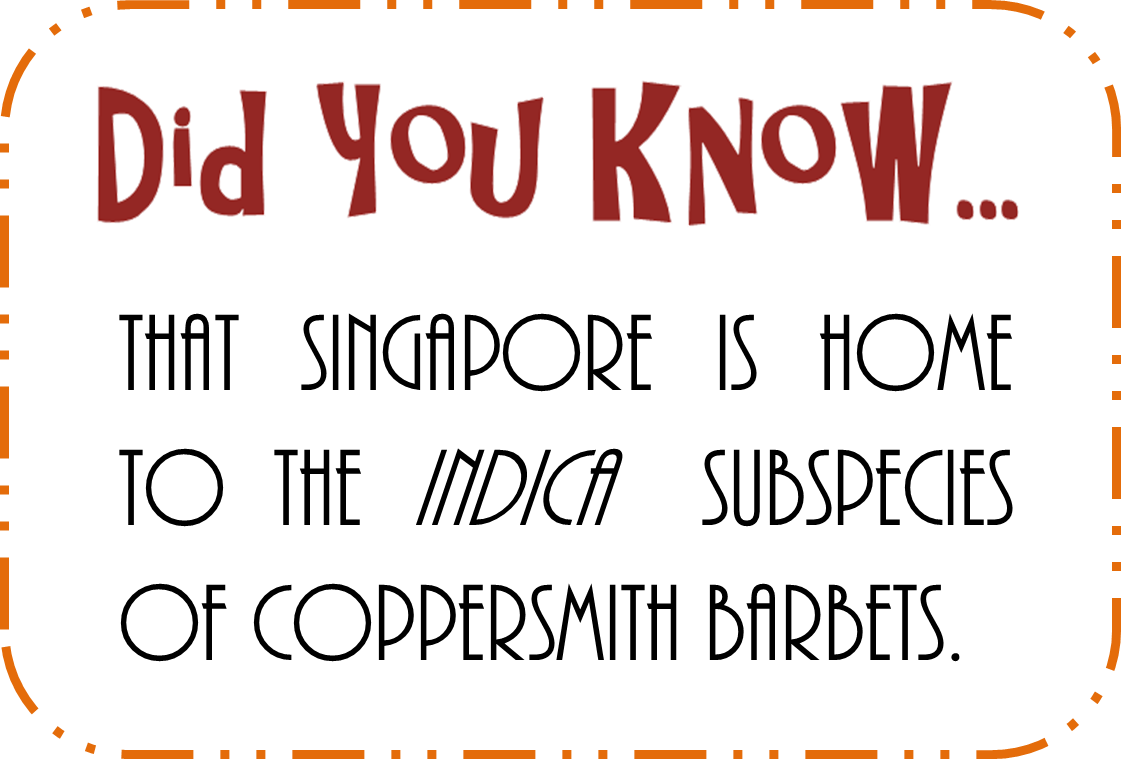
There are nine subspecies of Coppersimth barbets that exist within Asia [54] . They are as follows: (Information retrieved from Avibase: http://avibase.bsc-eoc.org/species.jsp?lang=EN&avibaseid=2B7AC50ED78F524F&sec=summary )| Subspecies |
Described by, in |
Range |
| haemacephala |
P. L. S. Müller, 1776 |
Islands of Luzon and Midoro |
| indica |
Latham, 1790 |
India, China and Southeast Asia |
| delica |
Parrot, 1907 |
Sumatra |
| rosea |
Dumont, 1816 |
Java |
| homochroa |
Dziadosz & Parkes, 1984 |
Tablas |
| celestinoi |
Gilliard, 1949 |
Catanduanes, Biliran, Samar, Leyte |
| intermedia |
Shelley, 1891 |
Panay, Guimaras, Negros |
| cebuensis |
Dziadosz & Parkes, 1984 |
Cebu |
| mindanensis |
Rand, 1948 |
Mindanao |
8.3. Type information
Type information was obtained from Yale Peabody Museum [56] . This is not information of the holotype, for which no information was found.| Locality : |
Asia; Thailand; Nan Province; Ban Leech |
| Collector : |
K. Thonglongnya |
| Collecting date : |
1956-11-16 |
| Collection location |
Asia; Thailand |
| Rights : |
Ornithology, Yale Peabody Museum |
| Sex : |
Male |
| Preparations : |
Skin, round |
| Catalog number : |
YPM ORN 039716 |
| Collection : |
Vertebrate Zoology |
| Repository : |
Yale Peabody Museum of Natural History |
8.4. Phylogeny
Originally described by Statius Muller in 1776 in Des Ritters Carl von Linné Königlich Schwedischen Leibarztes, the species was classified under the Bucco genus as Bucco haemacephalus (Muller,1776) [57] .In late 2014, the species was reclassified into the Rampastidae genus as Psilopogon haemacephalus by del Hoyo and Collar [58] .8.5. Evolution
Figure below shows relationship of Asian barbets to African and New World barbets. Figure indicates that the Asian barbets, including the Coppersmith barbet, are basal in origin in contrast to African and New World taxa[59] . The Coppersmith barbet is a basal species.
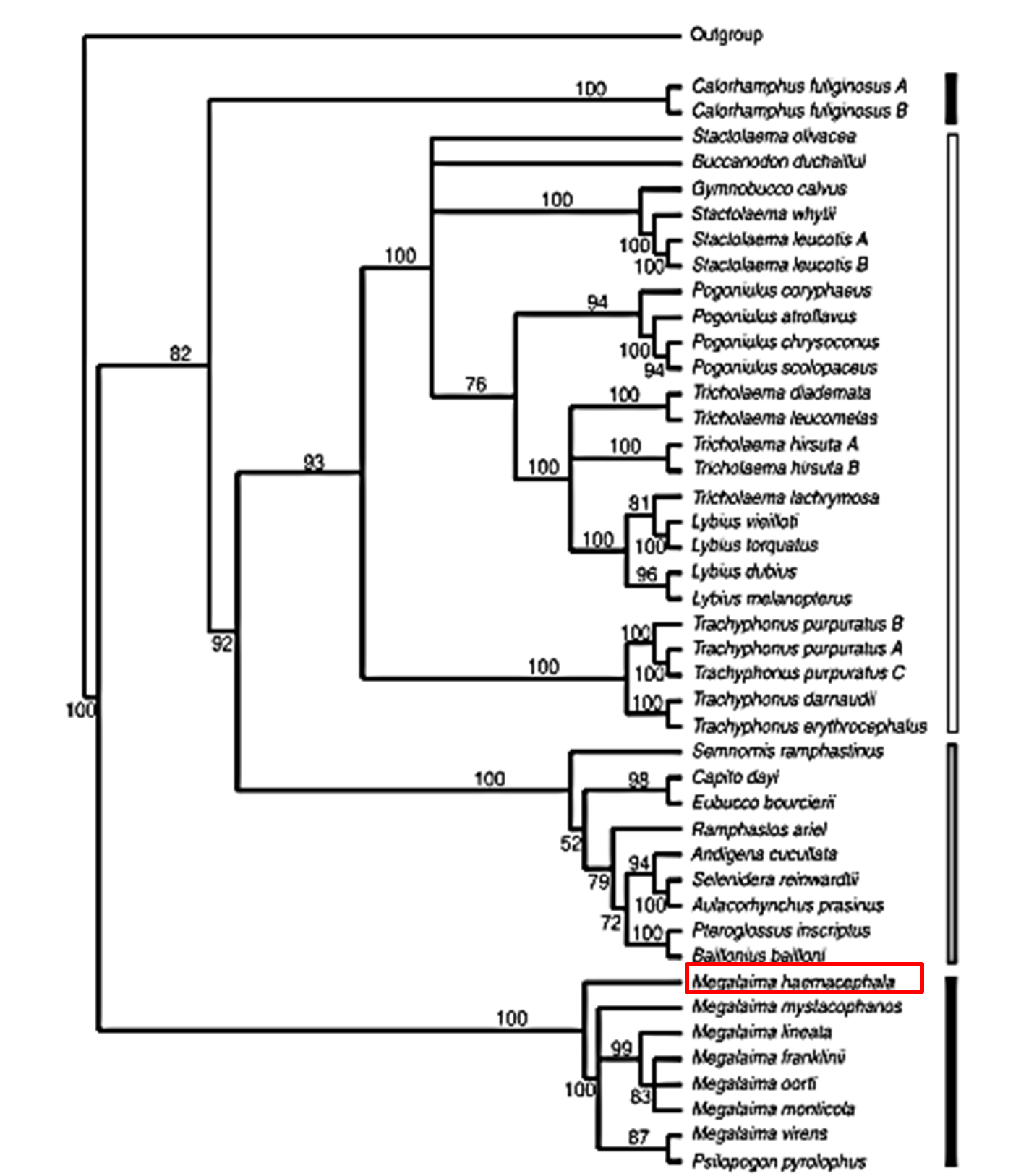 |
| “Majority rule consensus tree of 1000 parsimony bootstrap replicates from combined cyt b and FIB7 data set. Open bars are New World taxa, Gray bars are African taxa, Dark bars are Asian Taxa.” as taken from Phylogenetics of barbets (Aves: Picoformes) based on nuclear and mitochondrial DNA sequence data by Robert Moyle, permission pending. |
9. Copyright Information
Audio file of Coppersmith barbet call retrieved form Xeno-Canto licensed under the Creative Commons Attribution-NonCommercial-NoDerivs 4.0 license. Images taken from Wikimedia commons are licensed under the Creative Commons Attribution-Share Alike 2.0 Generic license.
Figure showing phylogenetics of the Coppersmith barbet taken from "Phylogenetics of barbets ( Aves: Picoformes) based on nuclear and mitochondrial DNA sequence data" by Robert Moyle, Permission pending.Map showing distribution of Coppersmith barbets taken from IUCN is free to use for non-commercial usage, and for use in education and conservation purposes as stated in Terms of Use.
Videos from Youtube are also licensed under the Creative Commons CC BY license.
10. References
- ^ “Barbets and Woodpeckers” by Tan K. H. Singapore Birds, 28 June 2012. URL: http://singaporebirds.blogspot.sg/2012/06/barbets-woodpeckers.html (accessed 11 Nov 2014)
- ^ Lok A. F. S. L., & Lee, T. K., 2009. Barbets of Singapore Part 2: Megalaima haemacephala indica Latham (coppersmith barbet), Singapore’s only native, urban barbet. Nature in Singapore, 2: 47-54
- ^ Lok A. F. S. L., & Lee, T. K., 2009. Barbets of Singapore Part 2: Megalaima haemacephala indica Latham (coppersmith barbet), Singapore’s only native, urban barbet. Nature in Singapore, 2: 47-54
- ^ Lok A. F. S. L., & Lee, T. K., 2009. Barbets of Singapore Part 2: Megalaima haemacephala indica Latham (coppersmith barbet), Singapore’s only native, urban barbet. Nature in Singapore, 2: 47-54
- ^ Muller P.L.S., 1776. Des Ritters Carl von Linné Königlich Schwedischen Leibarztes &c. &c. vollständigen Natursystems Supplements- und Register-Band über alle sechs Theile oder Classen des Thierreichs. Mit einer ausführlichen Erklärung. Nebst drey Kupfertafeln.Nürnberg
- ^ del Hoyo, J., N. J. Collar, D. A. Christie, D. A., A. Elliott, L. D. C. Fishpool, 2014. HBW and BirdLife International Illustrated Checklist of the Birds of the World. Lynx Edicions. BirdLife International.
- ^ “Megalaima haemacephala (Coppersmith Barbet)” by Encyclopedia of Life. EOL, n.d. URL: http://eol.org/pages/1177697/names/common_names (accessed 11 Nov 2014)
- ^ Muller P.L.S., 1776. Des Ritters Carl von Linné Königlich Schwedischen Leibarztes &c. &c. vollständigen Natursystems Supplements- und Register-Band über alle sechs Theile oder Classen des Thierreichs. Mit einer ausführlichen Erklärung. Nebst drey Kupfertafeln.Nürnberg
- ^ “Coppersmith barbet” by Wikipedia. Wikipedia, n.d. URL: http://en.wikipedia.org/wiki/Coppersmith_barbet (accessed 2 Nov 2014)
- ^ “Barbe” by WordReference. WordReference, n.d. URL: http://www.wordreference.com/fren/barbe (accessed 12 Nov 2014)
- ^ “Barbets and Woodpeckers” by Tan K. H. Singapore Birds, 28 June 2012. URL: http://singaporebirds.blogspot.sg/2012/06/barbets-woodpeckers.html (accessed 11 Nov 2014)
- ^ Lok A. F. S. L., & Lee, T. K., 2009. Barbets of Singapore Part 2: Megalaima haemacephala indica Latham (coppersmith barbet), Singapore’s only native, urban barbet. Nature in Singapore, 2: 47-54
- ^ "haem" by The Free Dictionary, n.d. URL: http://www.thefreedictionary.com/haem (accessed 23 November 2014)
- ^ "-cephalus" by The Free Dictionary, n.d. URL: http://medical-dictionary.thefreedictionary.com/-cephalus (accessed on 23 November 2014)
- ^ “Barbets and Woodpeckers” by Tan K. H. Singapore Birds, 28 June 2012. URL: http://singaporebirds.blogspot.sg/2012/06/barbets-woodpeckers.html (accessed 11 Nov 2014)
- ^ “Coppersmith barbet (Megalaima haemacephala) Picoforme Order – Ramphastidae Family” by Bouglouan N. Oiseaux Birds, n.d. URL: http://www.oiseaux-birds.com/card-coppersmith-barbet.html (accessed 11 Nov 2014)
- ^ “Coppersmith barbet (Megalaima haemacephala) Picoforme Order – Ramphastidae Family” by Bouglouan N. Oiseaux Birds, n.d. URL: http://www.oiseaux-birds.com/card-coppersmith-barbet.html (accessed 11 Nov 2014)
- ^ “Coppersmith barbet (Megalaima haemacephala) Picoforme Order – Ramphastidae Family” by Bouglouan N. Oiseaux Birds, n.d. URL: http://www.oiseaux-birds.com/card-coppersmith-barbet.html (accessed 11 Nov 2014)
- ^ “Barbets and Woodpeckers” by Tan K. H. Singapore Birds, 28 June 2012. URL: http://singaporebirds.blogspot.sg/2012/06/barbets-woodpeckers.html (accessed 11 Nov 2014)
- ^ “Coppersmith barbet (Megalaima haemacephala) Picoforme Order – Ramphastidae Family” by Bouglouan N. Oiseaux Birds, n.d. URL: http://www.oiseaux-birds.com/card-coppersmith-barbet.html (accessed 11 Nov 2014)
- ^ “Coppersmith barbet (Megalaima haemacephala) Picoforme Order – Ramphastidae Family” by Bouglouan N. Oiseaux Birds, n.d. URL: http://www.oiseaux-birds.com/card-coppersmith-barbet.html (accessed 11 Nov 2014)
- ^ Rasmussen, PC & JC Anderton, 2005. Birds of South Asia: The Ripley Guide. Smithsonian Institution & Lynx Edicions. 2: 279–280
- ^ Rasmussen, PC & JC Anderton, 2005. Birds of South Asia: The Ripley Guide. Smithsonian Institution & Lynx Edicions. 2: 279–280
- ^ Rasmussen, PC & JC Anderton, 2005. Birds of South Asia: The Ripley Guide. Smithsonian Institution & Lynx Edicions. 2: 279–280
- ^ Rasmussen, PC & JC Anderton, 2005. Birds of South Asia: The Ripley Guide. Smithsonian Institution & Lynx Edicions. 2: 279–280
- ^ “Barbets and Woodpeckers” by Tan K. H. Singapore Birds, 28 June 2012. URL: http://singaporebirds.blogspot.sg/2012/06/barbets-woodpeckers.html (accessed 11 Nov 2014)
- ^ “Barbets and Woodpeckers” by Tan K. H. Singapore Birds, 28 June 2012. URL: http://singaporebirds.blogspot.sg/2012/06/barbets-woodpeckers.html (accessed 11 Nov 2014)
- ^ “Barbets of Singapore” by Wee Y. C. Bird Ecology Study Group, 22 Aug 2008. URL: http://www.besgroup.org/2008/08/22/barbets-of-singapore/ (accessed 11 Nov 2014)
- ^ "XC200724 Coppersmith Barbet Megalaima haemacephala indica " by Frank Lambert. Xeno-Canto, 2014. URL: http://www.xeno-canto.org/200724XC (accessed 23 November 2014)
- ^ “Barbets of Singapore” by Wee Y. C. Bird Ecology Study Group, 22 Aug 2008. URL: http://www.besgroup.org/2008/08/22/barbets-of-singapore/ (accessed 11 Nov 2014)
- ^ "XC200724 Coppersmith Barbet Megalaima haemacephala indica " by Frank Lambert. Xeno-Canto, 2014. URL: http://www.xeno-canto.org/200724XC (accessed 23 November 2014)
- ^ Ali, S & S D Ripley (1983). Handbook of the birds of India and Pakistan. Oxford University Press. 4(2): 163–165
- ^ Ali, S & S D Ripley (1983). Handbook of the birds of India and Pakistan. Oxford University Press. 4(2): 163–165
- ^ Ali, S & S D Ripley (1983). Handbook of the birds of India and Pakistan. Oxford University Press. 4(2): 163–165
- ^ “Coppersmith barbet calls you.wav” by Sheerang Kaulgi. Youtube, 12 Jun 2010. URL: http://www.youtube.com/watch?v=CIKPPdI2ylo (accessed 12 Nov 2014)
- ^ Ali, S & S D Ripley (1983). Handbook of the birds of India and Pakistan. Oxford University Press. 4(2): 163–165
- ^ Ali, S & S D Ripley (1983). Handbook of the birds of India and Pakistan. Oxford University Press. 4(2): 163–165
- ^ “Coppersmith barbet (Megalaima haemacephala) Picoforme Order – Ramphastidae Family” by Bouglouan N. Oiseaux Birds, n.d. URL: http://www.oiseaux-birds.com/card-coppersmith-barbet.html (accessed 11 Nov 2014)
- ^ Ali, S & S D Ripley (1983). Handbook of the birds of India and Pakistan. Oxford University Press. 4(2): 163–165
- ^ Aitken E.H., 1893. The habits of the coppersmith. Journal of Bombay Natural History Society. 8(2): 326-327
- ^ Bharos A.M.k., 1997. Unusual feeding pattern and diet of Crimsonbreasted barbet (Megalaima haemacephala). Journal of Bombay Natural History Society. 94(2): 411
- ^ Muthukrishnan T.S., Sundarbabu, Rajeswari, 1982. Feeding habits of Coppersmith Megalaima hameacephala (Muller). Journal of Bombay Natural History Society 79(1): 197-198
- ^ “Barbets of Singapore” by Wee Y. C. Bird Ecology Study Group, 22 Aug 2008. URL: http://www.besgroup.org/2008/08/22/barbets-of-singapore/ (accessed 11 Nov 2014)
- ^ Sarker N. J., M. F. Jaman, S. Mustafa, M. S. Rahman, 2013. Breeding biology of coppersmith barbet, Megalaima haemacephala (Muller, 1776). University Journal of Zoology, Rajshahi University, 31: 31-34
- ^ Sarker N. J., M. F. Jaman, S. Mustafa, M. S. Rahman, 2013. Breeding biology of coppersmith barbet, Megalaima haemacephala (Muller, 1776). University Journal of Zoology, Rajshahi University, 31: 31-34
- ^ “Bird Species Distribution Maps of the World 2012: Psilopogon haemacephalus” by BirdLife International and NatureServe, 2014. The IUCN Red List of Threatened Species. Version 2014.2 URL: http://maps.iucnredlist.org/map.html?id=22681681 (accessed 12 Nov 2014)
- ^ “Barbets and Woodpeckers” by Tan K. H. Singapore Birds, 28 June 2012. URL: http://singaporebirds.blogspot.sg/2012/06/barbets-woodpeckers.html (accessed 11 Nov 2014)
- ^ “Barbets and Woodpeckers” by Tan K. H. Singapore Birds, 28 June 2012. URL: http://singaporebirds.blogspot.sg/2012/06/barbets-woodpeckers.html (accessed 11 Nov 2014)
- ^ Lok A. F. S. L., & Lee, T. K., 2009. Barbets of Singapore Part 2: Megalaima haemacephala indica Latham (coppersmith barbet), Singapore’s only native, urban barbet. Nature in Singapore, 2: 47-54
- ^ “Psilopogon haemacephalus Fact sheet” by BirdLife International, 2012 . The IUCN Red List of Threatened Species. Version 2014.2. URL: http://www.iucnredlist.org/details/summary/22681681/0 (accessed 12 Nov 2014).
- ^ “2001 Categories & Criteria (Version 3.1)” by IUCN. IUCN, n.d. URL: http://www.iucnredlist.org/static/categories_criteria_3_1 (accessed 12 Nov 2014)
- ^ del Hoyo J., A. Elliott, J. Sargatal, 2002. Handbook of the Birds of the World: Jacamars to Woodpeckers. Lynx Edicions, Barcelona, Spain. 7
- ^ “Coppersmith barbet (Psilopogon haemacephalus) (Statius Muller,1776)” by Avibase. Avibase, n.d. URL: http://avibase.bsc-eoc.org/species.jsp?lang=EN&avibaseid=2B7AC50ED78F524F&sec=summary (Accessed 12 Nov 2014)
- ^ “Coppersmith barbet (Psilopogon haemacephalus) (Statius Muller,1776)” by Avibase. Avibase, n.d. URL: http://avibase.bsc-eoc.org/species.jsp?lang=EN&avibaseid=2B7AC50ED78F524F&sec=summary (Accessed 12 Nov 2014)
- ^ “Coppersmith barbet (Psilopogon haemacephalus) (Statius Muller,1776)” by Avibase. Avibase, n.d. URL: http://avibase.bsc-eoc.org/species.jsp?lang=EN&avibaseid=2B7AC50ED78F524F&sec=summary (Accessed 12 Nov 2014)
- ^ “Megalaima haemacephala, (Muller,1776) YPM, VZ, YPM ORN 039716” by iDigBio. iDigBio, n.d. URL: https://www.idigbio.org/portal/records/9b603c8b-3083-4708-9047-7b53f39aa0de (accessed 11 Nov 2014)
- ^ Muller P.L.S., 1776. Des Ritters Carl von Linné Königlich Schwedischen Leibarztes &c. &c. vollständigen Natursystems Supplements- und Register-Band über alle sechs Theile oder Classen des Thierreichs. Mit einer ausführlichen Erklärung. Nebst drey Kupfertafeln.Nürnberg
- ^ del Hoyo, J., N. J. Collar, D. A. Christie, D. A., A. Elliott, L. D. C. Fishpool, 2014. HBW and BirdLife International Illustrated Checklist of the Birds of the World. Lynx Edicions. BirdLife International.
- ^ Moyle R. G., 2004. Phylogenetics of barbets ( Aves: Picoformes) based on nuclear and mitochondrial DNA sequence data. Molecular Phylogenetics and Evolution. 30(1): 187-200
